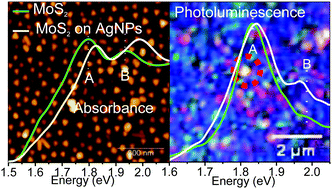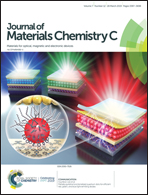Electromagnetic plasmonic field of nanoparticles tune the band gap of two-dimensional semiconducting materials†
Abstract
The strong spin–orbital coupling in the two-dimensional semiconducting materials i.e. MoS2 sheets, originated from the d orbitals of Mo atoms, splits their valence band at the K and K′ valleys of the Brillouin zone into two levels. Ultra-high-resolution absorption, photoluminescence (PL), and Raman measurements conducted for an individual MoS2 sheet functionalized with polymer on the top of silver nanoparticle arrays suggested that the plasmon–exciton interaction and photothermal mechanisms are not supported. A direct correlation between the strength of the electromagnetic plasmon field of the silver nanoparticle arrays, calculated by finite time domain difference technique, and the energy difference between A and B absorption and PL peaks is observed. This suggested that the electromagnetic field of the plasmonic nanoparticles altered the spin–orbital coupling in the MoS2 thus changed the ground state splitting. Silver nanoparticle arrays such as nanotetrahedron (AgNT) and nanocube (AgNC) are used. AgNT 2D arrays with different sizes were prepared on glass substrates by the overgrowth of silver hemispheres, while AgNC 2D arrays were prepared by the overgrowth of silver monolayers.



 Please wait while we load your content...
Please wait while we load your content...